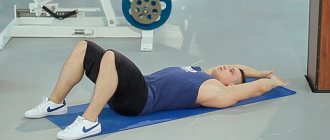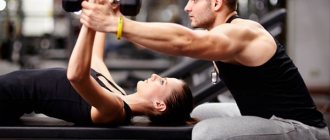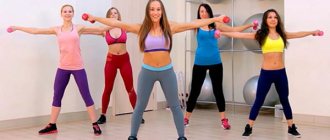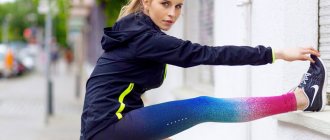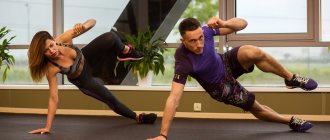Hello, dear readers! The other day I met one of my friends, and I was pleasantly surprised at how quickly she managed to lose weight and bounce back after giving birth. I bombarded her with questions, but there was only one answer. Deciding which sport would most quickly and safely help her regain her figure, a friend chose fitball exercises to lose weight after giving birth. Today I propose to talk about effective exercises in the first stages of recovery and when the body is already strong enough, as well as how to choose a magic ball.
Fitness trainers idea
Inflatable balls with a diameter of 45 to 85 cm are known as medicine balls, fitballs or resist-a-balls. Initially, this ball was actually invented for medical purposes and since the 50s of the 20th century it has been widely used in physical therapy. The ball allows you to load your muscles while sparing your joints.
That is why in the 80s fitball attracted the attention of inquisitive American fitness trainers. “Why not try losing weight with a ball like this?” Indeed, for overweight people, especially when they are over 30 years old, it is often their joints that do not allow them to engage in regular aerobics. So fitball has taken a strong place in fitness and has become an excellent workout for losing excess weight. They practice it in fitness clubs, at home with video discs, and on their own.
How long should I wait after giving birth for exercise to be safe?
Before training, be sure to consult a gynecologist, having received his permission, taking into account the individual characteristics of your health condition.
When can you start exercising on a fitball? Usually the following rules are followed:
- after natural childbirth without complications - after 2 months;
- after a caesarean section - after six months, while Kegel exercises for training the pelvic floor muscles are allowed to begin after 3-4 months (read how the Kegel system will help here).
Workhorse
What is the weight loss effect of exercise on a fitball based on? Unlike aerobics, running or swimming, your heart rate does not rise very high. However, even just sitting on the ball, we are forced to maintain balance. And this is very energy-intensive work, although we, as a rule, do not notice it. To maintain balance, it is not the muscles that we usually train with exercises that work, but deeper ones, which cannot be touched at all by standard exercises on the floor or with dumbbells. These are the so-called internal muscles of the body, located mainly in the depths of the abdomen and lower back. They are responsible for the effect of a slim waist.
The exercises themselves on the fitball are aimed primarily at strengthening the muscles of the abdomen, buttocks, thighs and back. Each of them burns more calories than if we did it without the ball. Thus, in an hour of exercise on a fitball you can burn about 400 kcal, and in a month of regular exercise (2-4 times a week) you can lose 2-3 kg! In addition, like any physical exercise, the miracle ball trains the cardiovascular and respiratory systems, increases endurance and coordination, and improves the condition of the spine. It is also comfortable and pleasant to stretch on.
Why fitball?
For more than 30 years, the big, bright ball has helped millions of postpartum women get into and even improve their prenatal shape. Fitball is often used for successful rehabilitation after injuries and operations, because exercises on it are safe and effective for people of all ages.
The ball will help prepare your body for further training if you plan to go to the gym or run in the future. If you choose the optimal and safe sport while breastfeeding, then fitball is ideal (find out about other suitable sports in my detailed post).
A properly selected set of exercises will help:
- strengthen the back and abdominal muscles;
- improve coordination of movements;
- awaken every muscle, relax it or tone it;
- train your joints;
- give the body flexibility;
- gain a sense of balance;
- recharge with vital energy;
- improve mood.
Read about other ways to quickly regain your figure after childbirth.
It is possible and it is not possible
Fitball has very few restrictions. It is not suitable only for those who have problems with the vestibular apparatus, who suffer from diseases of the cerebellum. But fitball is available and even recommended for older people, people with very large weights, pregnant women, those suffering from osteochondrosis, and those who have varicose veins or damaged ankle or knee joints.
To experience all the benefits of fitball, you need to follow simple rules.
Choose the right ball size! Each height has its own diameter. When you sit on a stability ball, your thighs should be approximately parallel to the floor, and your knee angle should be almost straight (95-110°). If your knee angle is greater, you will not be able to exercise effectively. If less, the load on the knee and hip joints will increase.
When sitting on the ball, do not slouch, do not lower your chin to your chest, keep your shoulders turned.
When you lie on your stomach, lean on your hands and raise your leg, do not arch your lower back - this can lead to injury. Do not lean your body forward so that its weight is transferred to your arms - this is dangerous for your hands and elbows. Let as much of your body weight rest on the ball. During all exercises, try to keep your stomach tense and do not move your body from side to side. This will increase the fat burning effect.
When can I start classes?
You should start working on improving your physical fitness a few months after giving birth. Every woman should “feel” her body, and recovery can occur differently for everyone. Only after six months, or even more, can you begin increased loads.
After natural childbirth
After a month and a half, if the birth was without any complications, you can start doing exercises. But taking into account the characteristics and individuality of each organism, before you start strengthening your muscles, you need to seek advice from your gynecologist.
After caesarean section
Artificial childbirth forces a woman to restore her body a little longer and more difficult than after a normal birth. But it is simply necessary to do this. Physical activity strengthens the necessary muscle groups after surgery. You need to start with simple exercises, and only after your personal doctor allows it. You need to be extremely careful while performing the exercise. The postoperative period may be accompanied by severe fatigue, so you should choose a set of exercises that does not require a lot of effort. The load needs to be increased gradually.
Before you start doing the exercises, you need to remember some rules:
- the room needs to be well ventilated;
- start classes after breastfeeding;
- wear only comfortable clothes;
- perform movements smoothly;
- increase the loads little by little;
- Be sure to drink water between exercises;
- conduct classes regularly.
Choose the right ball
A fitball will cost you 300-2000 rubles; they are sold in specialized stores and hypermarkets. The more you weigh, the more load the ball should be designed to carry! Expensive models can withstand up to 150 kg. Make sure the ball you choose can support more than your own weight. Good balls also have protection against bursting (if damaged, such a ball will not burst under you, but will slowly deflate), which is indicated by the marking ABS (Anti-Burst System) or BRQ (Burst Resistant Quality). By the way, a damaged ball can be repaired like a bicycle inner tube.
The harder you pump the ball, the more difficult it will be to balance on it and the more calories you will burn. However, for beginners it is better not to experiment and get acquainted with the ball in a softer state. It is usually recommended to pump the ball so that when pressed it bends by 2-3 cm. If you are not confident in your coordination and sense of balance, feel free to make it even softer, over time you will get the hang of it and pump it up tighter.
It is not recommended to deflate the fitball after each workout; on the contrary, the ball is better preserved when inflated. To enhance calorie burning, we recommend using an inflated ball as a seat 2-3 times a day. Just sit on it for 15-30 minutes while watching TV or at the computer; the need to maintain balance will speed up your metabolism and have a beneficial effect on the condition of the spine.
How to exercise on a fitball for weight loss
The training is designed to work all muscle groups with an emphasis on women's problem areas. A set of exercises with a fitball for the abdomen, thighs, buttocks, and chest with a systematic approach will help in a couple of months to get sculpted abs, strengthen the back muscle corset and lose weight.
Exercises for losing weight at home with a ball will give quick results in combination with cardio. It's better to work according to the following scheme:
- perform a complex with a sphere for one day;
- the second is to move actively.
For aerobic exercise, choose an exercise bike, walking at a fast pace, dancing, or jogging. Training time is 30-40 minutes.
Exercises with a fitball for weight loss cannot be rushed.
- Perform the practices slowly and in a controlled manner.
- Always work with your stomach pulled in.
- Maneuver your body using your core muscles without using your arms.
- Before the main complex, do not forget to warm up.
Rest between exercises . Perform each technique 15-20 times.
It is advisable to train in a circular mode and reduce the pauses for respite by 2 times. This approach burns 25% more calories.
From theory to practice
In conclusion, we offer you some simple exercises that will help you lose excess fat from your stomach and buttocks. Perform each exercise 30-60 times 2-4 times a week.
1. Lying on the fitball on your stomach, rest your feet on the floor. Extend your arms horizontally in front of you as an extension of your back. Lower your body as far as possible, trying to touch the floor with your hands (do not lean on your hands!). Raise your body and arms to the starting position.
2. Lying on the exercise ball on your stomach, place your hands on the floor. Do not put your body on your hands, try to leave the main weight of your body on the ball. Straighten and tense your leg, slowly lift it up with your heel. Don't pull your toe out! Lower your leg just below the horizontal without touching the floor.
3. The starting position is the same. Raise your leg to the horizontal, straighten and tense. Take it to the side, bend it, straighten it and return it back. Do the exercise without lowering your leg to the floor.
4. Sit on the ball with your back straight. Straighten your legs. Bend towards your feet, alternately trying to touch the toe with your hands. If that doesn't work, touch your knee or shin with your hands. Don't round your back!
5. Sit deeply on the ball, stretch your arms in front of you. Lower yourself back, trying to lie on the ball, and return to the starting position.
Shaping the press
The first exercise in this category allows you to interact with the oblique abdominal muscles, which creates a slimmer waist. Starting position: lying on your back, hands behind your head, feet on the ball at a right angle. Lean forward, lifting your body off the floor so that your right knee meets your left elbow. Then lower yourself onto your back and repeat the exercise, but in the other direction.
The following advanced exercise will make your tummy flatter. You need to lie on your back, bend your legs at a right angle, grab and hold a gymnastic ball with your feet, hands under your back, palms down. Once you have taken the correct position, begin to pull your knees to your chest, while the ball should not touch the floor.
It is important that the angle of your legs does not change; work only with your pelvis.
By the way
Smooth or with horns?
Not all fitballs have a smooth surface. There are balls with small spikes that will complement the exercises with a massage effect. These balls are called touch or massage balls. Not bad against cellulite, but the spikes are quite hard and may not be suitable for sensitive people. Another type of ball has two handles in the form of horns or brackets. It has no practical benefit for losing weight, but it doesn’t interfere either. But children really like to jump on this ball, holding the handles.
Benefits of classes
Initially, fitball was intended for training with people suffering from cerebral palsy. But the results were so impressive that it began to be used when working with patients with spinal injuries. Gradually, exercises on a fitball became more and more popular, thanks to the benefits that exercises with it brought.
The benefits of classes are as follows:
- During exercise, you have to use more muscles to maintain balance. Due to this, a large number of calories are burned.
- By exercising on a fitball, you will strengthen the muscles of your abs, back, lumbar region and buttocks. The advantage is that the muscles that are “resting” during standard training begin to work.
- Exercises on a fitball are safe for the corset muscles of the back and lumbar region.
- Exercises on a rubber ball correct posture and relieve fatigue in the back muscles.
- Coordination improves, muscle elasticity and joint mobility increase.
- Due to the low load on the joints and spine, the risk of injury during such activities is minimal.
- Fitball is recommended for use during rehabilitation exercises for people with injuries of the spine and musculoskeletal system.
- People with varicose veins , ankle injuries and other leg-related injuries are also allowed to exercise on a fitball.
- Fitball is also suitable for pregnant women who want to maintain body elasticity.
- Exercises on a rubber ball have a beneficial effect on the nervous system.
- During training, you simultaneously need to coordinate the work of the motor and vestibular systems.
Exercises on a fitball are recommended not only for women who are losing weight, but also for those who want to maintain the normal functioning of the musculoskeletal system, relax the back muscles and add variety to their exercises.
Contraindications to ball exercises
Fitball is one of the few equipments, training on which has practically no contraindications. Each person can choose their own set of exercises on the ball, which will help lose excess weight and strengthen the muscles of the whole body. Contraindications include only severe diseases of the cardiovascular system, intervertebral hernia, as well as other serious pathologies of internal organs.
Fitball is one of the few sports equipment with which you can create many exercises with varying degrees of load and on different muscle groups. The effectiveness of training with a ball is explained by the fact that during training all muscle tissues are involved and strengthened. There are practically no contraindications to exercising with a ball.

